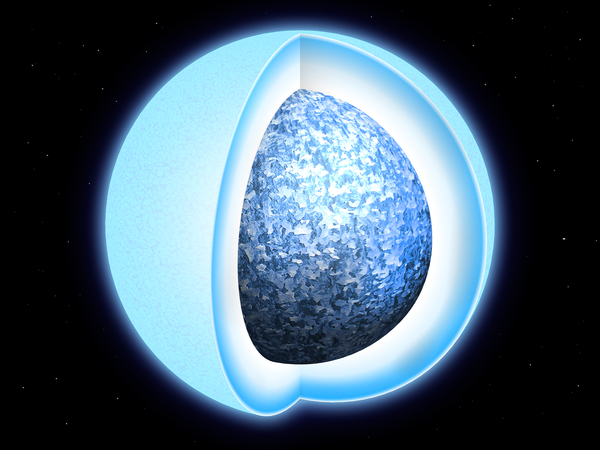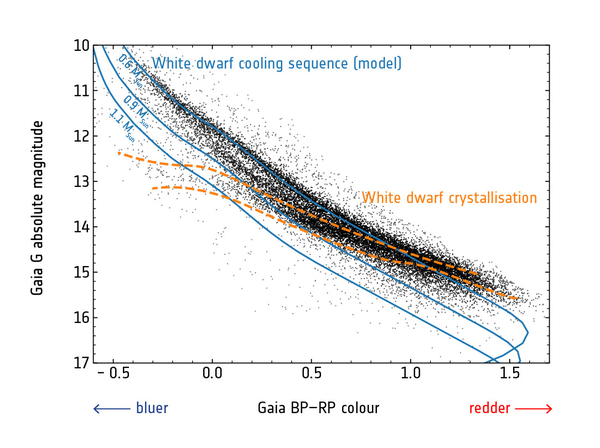Gaia reveals how Sun-like stars turn solid after their demise
9 January 2019
Data captured by ESA's galaxy-mapping spacecraft Gaia has revealed for the first time how white dwarfs, the dead remnants of stars like our Sun, turn into solid spheres as the hot gas inside them cools down. |
| Artist's impression of crystallisation in white dwarf. Credit: Mark Garlick; University of Warwick; European Research Council |
This process of solidification, or crystallisation, of the material inside white dwarfs was predicted 50 years ago but it wasn't until the arrival of Gaia that astronomers were able to observe enough of these objects with such a precision to see the pattern revealing this process.
"Previously, we had distances for only a few hundreds of white dwarfs and many of them were in clusters, where they all have the same age," says Pier-Emmanuel Tremblay from the University of Warwick, UK, lead author of the paper describing the results, published today in Nature.
"With Gaia we now have the distance, brightness and colour of hundreds of thousands of white dwarfs for a sizeable sample in the outer disc of the Milky Way, spanning a range of initial masses and all kinds of ages."
It is in the precise estimate of the distance to these stars that Gaia makes a breakthrough, allowing astronomers to gauge their true brightness with unprecedented accuracy.
White dwarfs are the remains of medium-sized stars similar to our Sun. Once these stars have burnt all the nuclear fuel in their core, they shed their outer layers, leaving behind a hot core that starts cooling down.
These ultra-dense remnants still emit thermal radiation as they cool, and are visible to astronomers as rather faint objects. It is estimated that up to 97 per cent of stars in the Milky Way will eventually turn into white dwarfs, while the most massive of stars will end up as neutron stars or black holes.
The cooling of white dwarfs lasts billions of years. Once they reach a certain temperature, the originally hot matter inside the star's core starts crystallising, becoming solid. The process is similar to liquid water turning into ice on Earth at zero degrees Celsius, except that the temperature at which this solidification happens in white dwarfs is extremely high – about 10 million degrees Celsius.
In this study, the astronomers analysed more than 15 000 stellar remnant candidates within 300 light years of Earth as observed by Gaia and were able to see these crystallising white dwarfs as a rather distinct group.
 |
| White dwarf cooling sequence and crystallisation. Credit: Courtesy of Pier-Emmanuel Tremblay et al. (2018) |
"We saw a pile-up of white dwarfs of certain colours and luminosities that were otherwise not linked together in terms of their evolution," says Pier-Emmanuel.
"We realised that this was not a distinct population of white dwarfs, but the effect of the cooling and crystallisation predicted 50 years ago."
The heat released during this crystallisation process, which lasts several billion years, seemingly slows down the evolution of the white dwarfs: the dead stars stop dimming and, as a result, appear up to two billion years younger than they actually are. That, in turn, has an impact on our understanding of the stellar groupings these white dwarfs are a part of.
"White dwarfs are traditionally used for age-dating of stellar populations such as clusters of stars, the outer disc, and the halo in our Milky Way," explains Pier-Emmanuel. "We will now have to develop better crystallisation models to get more accurate estimates of the ages of these systems."
Not all white dwarfs crystallise at the same pace. More massive stars cool down more rapidly and will reach the temperature at which crystallisation happens in about one billion years. White dwarfs with lower masses, closer to the expected end stage of the Sun, cool in a slower fashion, requiring up to six billion years to turn into dead solid spheres.
The Sun still has about five billion years before it becomes a white dwarf, and the astronomers estimate that it will take another five billion years after that to eventually cool down to a crystal sphere.
"This result highlights the versatility of Gaia and its numerous applications," says Timo Prusti, Gaia project scientist at ESA.
"It's exciting how scanning stars across the sky and measuring their properties can lead to evidence of plasma phenomena in matter so dense that cannot be tested in the laboratory."
Notes for editors
"Core crystallisation in evolving white dwarf stars from a pile up in the cooling sequence" by P.-E. Tremblay et al. is published in Nature.
Explore the Gaia Data Release 2 archive here.
For further information, please contact:
Pier-Emmanuel Tremblay
University of Warwick
Coventry, UK
Tel: +44 24765 28407
Mob: +44 74647 22697
Email: p-e.tremblay![]() warwick.ac.uk
warwick.ac.uk
Timo Prusti
Gaia Project Scientist
European Space Agency
Email: timo.prusti![]() esa.int
esa.int
Markus Bauer
ESA Science Communication Officer
Tel: +31 71 565 6799
Mob: +31 61 594 3 954
Email: markus.bauer![]() esa.int
esa.int


